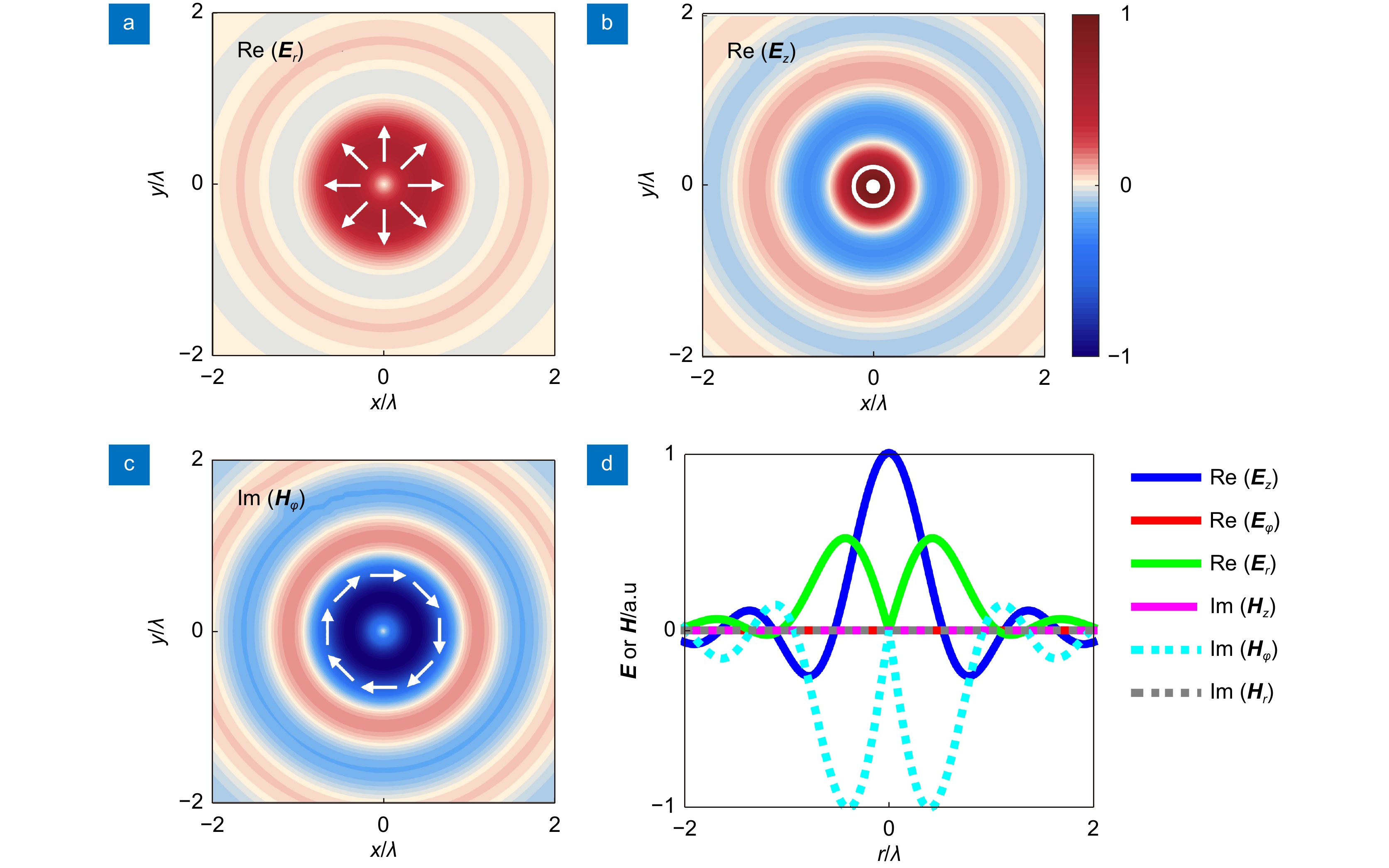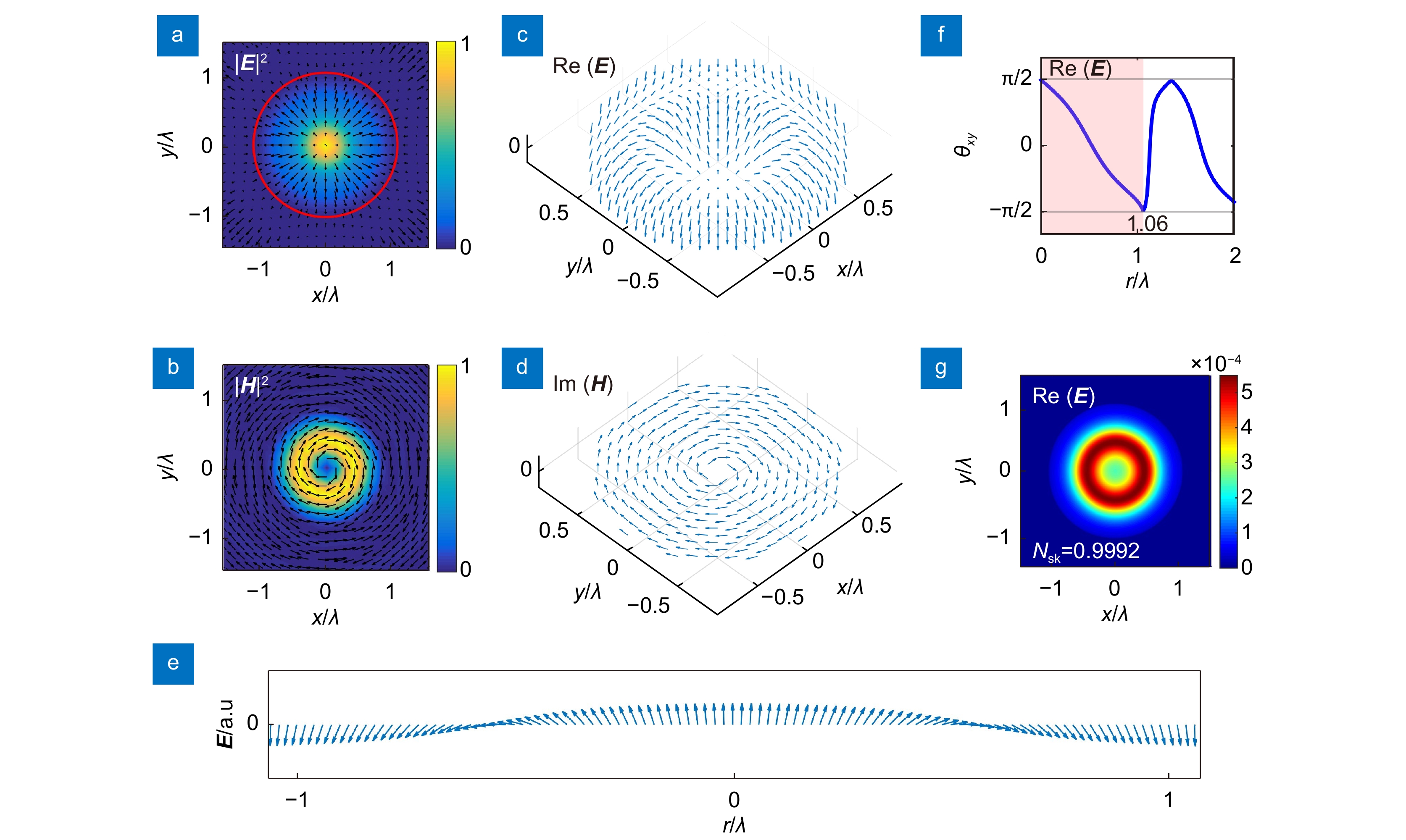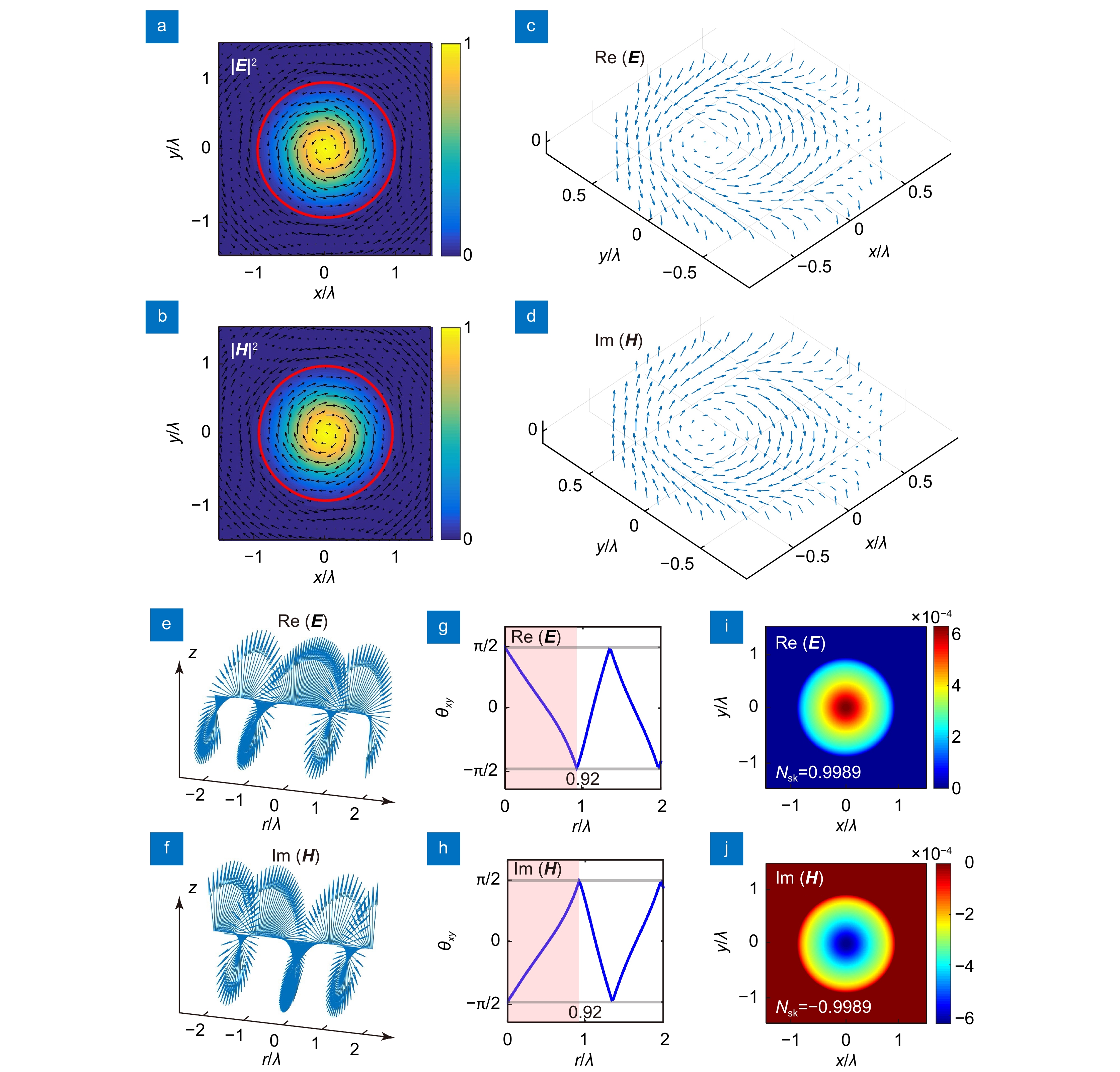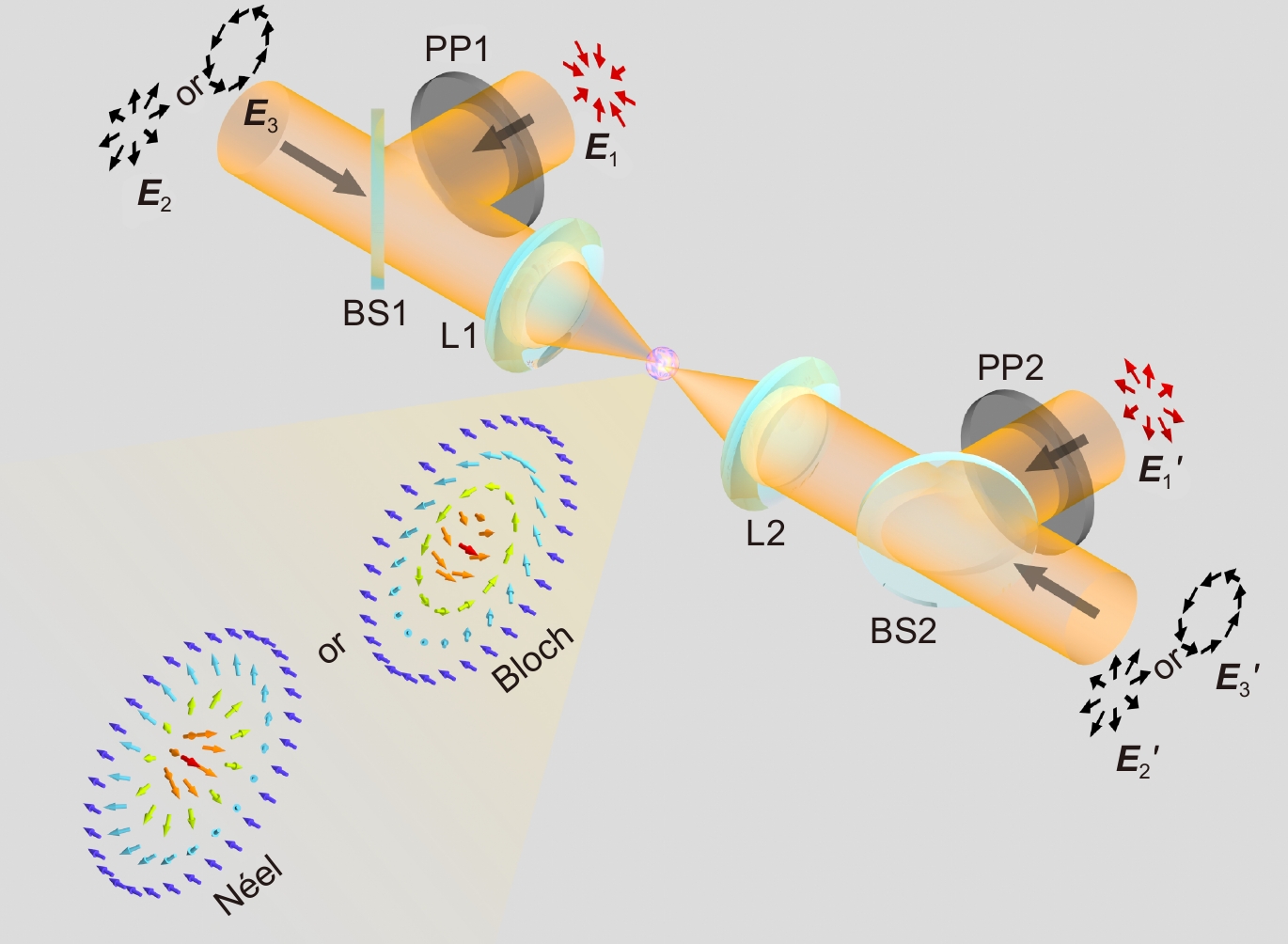Generation of optical skyrmions formed by electromagnetic field vectors under 4π focal configurations
-
摘要:
光学斯格明子为实现结构光场以及时空光场的拓扑属性提供了新的研究方法与研究思路。本文在4π聚焦系统中,通过对两对入射柱矢量光束进行偏振与相位调控,实现了聚焦光场纵向分量与横向分量的独立控制,在焦平面上得到了Néel型与Bloch型的电磁矢量光学斯格明子。在4π聚焦系统内调控两对反向传播的径向偏振光时,焦平面处将产生Néel型的电场矢量斯格明子。将其中一对替换为角向偏振光时,焦平面处将同时产生Bloch型的电场矢量斯格明子与相位超前π/2的磁场矢量斯格明子。本工作为进一步研究自由空间中微纳尺度电磁矢量光学斯格明子与物质的相互作用提供了理论基础。
Abstract:Optical skyrmions provide a new idea and approach to endow structured light and spatial-temporal light with topological properties. In this paper, the longitudinal and transversal components of the focused light field are decoupled and can be controlled independently by modulating the polarizations and phases of two pairs of counter-propagating incident cylindrical vector beams under 4π focal configuration. Under this condition, Néel-type and Bloch-type optical skyrmions formed by electromagnetic field vectors are constructed in the focal plane. When one pair of the incident beams is radially polarized with a phase difference of π and the other pair is radially polarized in phase, a Néel-type optical skyrmion formed by electric field vectors can be constructed in the focal plane of the 4π focal system. The corresponding focal magnetic field is purely azimuthally polarized. If we substitute the other pair of the incident beams with azimuthally polarized beams, Bloch-type optical skyrmions formed by electromagnetic field vectors can be constructed in the focal plane, where the one formed by magnetic field vectors has a π/2 phase lead compared with the that formed by electric field vectors. This work provides a theoretical basis for further research on the interactions between matter and optical skyrmions formed by electromagnetic field vectors at micro and nano scales in free space.
-
Key words:
- vector beams /
- 4π focal configurations /
- optical skyrmions
-
Overview: Topological photonics inspired by the discovery of photonic topological insulators opens a path towards the discovery of fundamentally new states of light and potentially revolutionary applications, such as slow light, photonic circuitry, and topologically protected lasing. Recently, optical skyrmions, emerging as fire-new objects of study in topological photonics, were first proposed by Shai Tsesses and Luping Du et al. and may provide a new idea and approach to endow structured light and spatial-temporal light with topological properties. Resorting to vector field manipulations, different types of optical skyrmions have been generated in free space or by controlling the evanescent waves propagating along the surface of metal films. One of the most significant potential applications of optical skyrmions is the realization of the novel phenomena excited by the skyrmion-matter interactions at micro and nano scales, which could be applied to optical storage, high-resolution imaging, and precision metrology. However, there always exists a π/2 phase difference between the longitudinal and the transversal components of the focused light field under traditional tightly focusing systems in free space, and hence the generation of micro- or nano-scale optical skyrmions formed by electromagnetic field vectors in free space is still a challenge in this flourishing field.
-

-
图 1 4π聚焦条件下,两对相向传播的柱矢量入射光在聚焦空间中产生电磁矢量光学斯格明子示意图。PP1、PP2:相位延迟为π/2的均匀相位板,BS1、BS2:分束器,L1、L2:聚焦物镜
Figure 1. Schematic of the generation of optical skyrmions formed by electromagnetic field vectors in the focal region of two pairs of counter-propagating cylindrical vector beams under 4π focal condition. PP1, PP2: homogeneous phase plate with a phase delay of π/2; BS1, BS2: beam splitter; L1, L2: objectives
图 2 Néel型电场矢量斯格明子各分量在焦平面上的归一化分布。(a)~(b) 聚焦电场径向分量和纵向分量在焦平面上的归一化分布;(c) 聚焦磁场角向分量在焦平面上的归一化分布;(d) 聚焦电磁场各分量的归一化截面曲线分布
Figure 2. Normalized distributions of the components of the Néel-type optical skyrmion formed by electric field vectors in the focal plane. (a)~(b) Radial and longitudinal components of the focused electric field in the focal plane; (c) Angular component of the focused magnetic field in the focal plane; (d) The cross sections of the individual components of the focused electromagnetic field
图 3 Néel型电场矢量斯格明子在焦平面上的矢量分布。(a)~(b) 聚焦电场和聚焦磁场在焦平面上的归一化能量密度分布,黑色箭头表示电场或磁场单位矢量在焦平面上的投影;(c) 由(a)中红色圆圈内的单位矢量构成的电场斯格明子的三维矢量结构;(d) 由(b)中中心区域的磁场单位矢量形成的二维角向分布;(e) 电场单位矢量沿斯格明子结构径向的取向变化;(f) 电场矢量相对于x-y平面的方向角θxy随r的变化;(g) 电场矢量斯格明子在焦平面上的斯格明子数密度分布
Figure 3. Vectorial distributions of the Néel-type optical skyrmion formed by electric field vectors in the focal plane. (a)~(b) Normalized energy density distributions of the focused electric field and magnetic field in the focal plane. The black arrows represent the projections of the electric or magnetic field unit vectors on the focal plane; (c) Three-dimensional vectorial structure of the optical skyrmion formed by electric field vectors within the red circle in (a); (d) Two-dimensional vectorial structure of the focal magnetic field in the central region of (b); (e) Orientations of the electric field unit vectors along the radial direction of the constructed Néel-type optical skyrmion; (f) Variation of θxy versus r; (g) Skyrmion numberdensity distribution of the constructed optical skyrmion in the focal plane
图 4 Bloch型电磁矢量斯格明子各分量在焦平面上的归一化分布。(a)~(b) 聚焦电场矢量角向分量和纵向分量在焦平面上的归一化分布;(c)~(d) 聚焦磁场矢量角向分量和纵向分量在焦平面上的归一化分布;(e) 聚焦电磁场各分量的归一化截面曲线分布
Figure 4. Normalized distributions of the components of the Bloch-type optical skyrmions formed by electromagnetic field vectors in the focal plane. (a)~(b) Angular and the longitudinal components of the focused electric field in the focal plane; (c)~(d) Angular and longitudinal components of the focused magnetic field in the focal plane; (e) Cross sections of the individual components of the focused electromagnetic field
图 5 Bloch型电磁矢量斯格明子在焦平面上的矢量分布。(a)~(b) 聚焦电场和聚焦磁场在焦平面上的归一化能量密度分布,黑色箭头表示电场或磁场单位矢量在焦平面上的投影;(c)~(d) 由(a)和(b)中红色圆圈内的单位矢量构成的电场与磁场斯格明子的三维矢量结构;(e)~(f) 电场与磁场的单位矢量沿斯格明子结构径向的取向变化;(g)~(h) 电场与磁场矢量相对于x-y平面的方向角θxy随r的变化;(i) ~(j) 电场与磁场矢量斯格明子在焦平面上的斯格明子数密度分布
Figure 5. Vectorial distributions of the Bloch-type optical skyrmions formed by electromagnetic field vectors in the focal plane. (a)~(b) Normalized energy density distributions of the focused electric field and magnetic field in the focal plane. The black arrows represent the projections of the electric or magnetic field unit vectors on the focal plane; (c)~(d) Three-dimensional vectorial structures of the optical skyrmions formed by electromagnetic field vectors within the red circles in (a) and (b); (e)~(f) Orientations of the electric field unit vectors and the magnetic field unit vectors along the radial directions of the constructed Bloch-type optical skyrmions; (g)~(h) Variations of θxy versus r; (i)~(j) Skyrmion number density distributions of the constructed optical skyrmions in the focal plane
-
[1] Rivera N, Kaminer I. Light–matter interactions with photonic quasiparticles[J]. Nat Rev Phys, 2020, 2(10): 538−561. doi: 10.1038/s42254-020-0224-2
[2] Song M W, Feng L, Huo P C, et al. Versatile full-colour nanopainting enabled by a pixelated plasmonic metasurface[J]. Nat Nanotechnol, 2023, 18(1): 71−78. doi: 10.1038/s41565-022-01256-4
[3] Zhang Y X, Pu M B, Jin J J, et al. Crosstalk-free achromatic full Stokes imaging polarimetry metasurface enabled by polarization-dependent phase optimization[J]. Opto-Electron Adv, 2022, 5(11): 220058. doi: 10.29026/oea.2022.220058
[4] Shen Y, Zhang Q, Shi P, et al. Topological quasiparticles of light: optical skyrmions and beyond[Z]. arXiv: 220510329, 2022. https://doi.org/10.48550/arXiv.2205.10329.
[5] Skyrme T H R. A unified field theory of mesons and baryons[J]. Nucl Phys, 1962, 31: 556−569. doi: 10.1016/0029-5582(62)90775-7
[6] Fert A, Cros V, Sampaio J. Skyrmions on the track[J]. Nat Nanotechnol, 2013, 8(3): 152−156. doi: 10.1038/nnano.2013.29
[7] Kézsmárki I, Bordács S, Milde P, et al. Néel-type skyrmion lattice with confined orientation in the polar magnetic semiconductor GaV4S8[J]. Nat Mater, 2015, 14(11): 1116−1122. doi: 10.1038/nmat4402
[8] Maccariello D, Legrand W, Reyren N, et al. Electrical detection of single magnetic skyrmions in metallic multilayers at room temperature[J]. Nat Nanotechnol, 2018, 13(3): 233−237. doi: 10.1038/s41565-017-0044-4
[9] Nagaosa N, Tokura Y. Topological properties and dynamics of magnetic skyrmions[J]. Nat Nanotechnol, 2013, 8(12): 899−911. doi: 10.1038/nnano.2013.243
[10] Romming N, Hanneken C, Menzel M, et al. Writing and deleting single magnetic skyrmions[J]. Science, 2013, 341(6146): 636−639. doi: 10.1126/science.1240573
[11] Sampaio J, Cros V, Rohart S, et al. Nucleation, stability and current-induced motion of isolated magnetic skyrmions in nanostructures[J]. Nat Nanotechnol, 2013, 8(11): 839−844. doi: 10.1038/nnano.2013.210
[12] Yu X Z, Kanazawa N, Zhang W Z, et al. Skyrmion flow near room temperature in an ultralow current density[J]. Nat Commun, 2012, 3(1): 988. doi: 10.1038/ncomms1990
[13] Tsesses S, Ostrovsky E, Cohen K, et al. Optical skyrmion lattice in evanescent electromagnetic fields[J]. Science, 2018, 361(6406): 993−996. doi: 10.1126/science.aau0227
[14] Du L P, Yang A P, Zayats A V, et al. Deep-subwavelength features of photonic skyrmions in a confined electromagnetic field with orbital angular momentum[J]. Nat Phys, 2019, 15(7): 650−654. doi: 10.1038/s41567-019-0487-7
[15] Shen Y J, Hou Y N, Papasimakis N, et al. Supertoroidal light pulses as electromagnetic skyrmions propagating in free space[J]. Nat Commun, 2021, 12(1): 5891. doi: 10.1038/s41467-021-26037-w
[16] Shen Y J, Martínez E C, Rosales-Guzmán C. Generation of optical skyrmions with tunable topological textures[J]. ACS Photonics, 2022, 9(1): 296−303. doi: 10.1021/acsphotonics.1c01703
[17] Lei X R, Yang A P, Shi P, et al. Photonic spin lattices: symmetry constraints for skyrmion and meron topologies[J]. Phys Rev Lett, 2021, 127(23): 237403. doi: 10.1103/PhysRevLett.127.237403
[18] Shi P, Du L P, Yuan X C. Spin photonics: from transverse spin to photonic skyrmions[J]. Nanophotonics, 2021, 10(16): 3927−3943. doi: 10.1515/nanoph-2021-0046
[19] Lin M, Zhang W L, Liu C, et al. Photonic spin skyrmion with dynamic position control[J]. ACS Photonics, 2021, 8(9): 2567−2572. doi: 10.1021/acsphotonics.1c00762
[20] Bai C Y, Chen J, Zhang Y X, et al. Dynamic tailoring of an optical skyrmion lattice in surface plasmon polaritons[J]. Opt Express, 2020, 28(7): 10320−10328. doi: 10.1364/OE.384718
[21] 何金枫, 王吉明, 刘友文, 等. Ince-Gaussian矢量光场束腰位置对紧聚焦特性影响的研究[J]. 激光技术, 2021, 45(1): 1−6. doi: 10.7510/jgjs.issn.1001-3806.2021.01.001
He J F, Wang J M, Liu Y W, et al. Research on the effect of waist position changing of Ince-Gaussian vectorial beam on tightly focusing characteristics[J]. Laser Technol, 2021, 45(1): 1−6. doi: 10.7510/jgjs.issn.1001-3806.2021.01.001
[22] Lu Y D, Xu Y, Ouyang X, et al. Cylindrical vector beams reveal radiationless anapole condition in a resonant state[J]. Opto-Electron Adv, 2022, 5(4): 210014. doi: 10.29026/oea.2022.210014
[23] 夏小兰, 曾宪智, 宋世超, 等. 基于柱矢量光调控的纵向超分辨率准球形多焦点阵列[J]. 光电工程, 2022, 49(11): 220109. doi: 10.12086/oee.2022.220109
Xia X L, Zeng X Z, Song S C, et al. Longitudinal super-resolution spherical multi-focus array based on column vector light modulation[J]. Opto-Electron Eng, 2022, 49(11): 220109. doi: 10.12086/oee.2022.220109
[24] Wang X Y, Rui G H, Gong L P, et al. Manipulation of resonant metallic nanoparticle using 4Pi focusing system[J]. Opt Express, 2016, 24(21): 24143−24152. doi: 10.1364/OE.24.024143
[25] Cui W J, Song F, Song F F, et al. Trapping metallic particles under resonant wavelength with 4π tight focusing of radially polarized beam[J]. Opt Express, 2016, 24(18): 20062−20068. doi: 10.1364/OE.24.020062
[26] Chen Z Y, Zhao D M. 4Pi focusing of spatially modulated radially polarized vortex beams[J]. Opt Lett, 2012, 37(8): 1286−1288. doi: 10.1364/OL.37.001286
[27] Yan S H, Yao B L, Rupp R. Shifting the spherical focus of a 4Pi focusing system[J]. Opt Express, 2011, 19(2): 673−678. doi: 10.1364/OE.19.000673
[28] Chen W B, Zhan Q W. Creating a spherical focal spot with spatially modulated radial polarization in 4Pi microscopy[J]. Opt Lett, 2009, 34(16): 2444−2446. doi: 10.1364/OL.34.002444
[29] Bokor N, Davidson N. Toward a spherical spot distribution with 4π focusing of radially polarized light[J]. Opt Lett, 2004, 29(17): 1968−1970. doi: 10.1364/OL.29.001968
[30] Gu M. Advanced Optical Imaging Theory[M]. Berlin Heidelberg: Springer, 2000. https://doi.org/10.1007/978-3-540-48471-4.
[31] Wang S C, Cao Y Y, Li X P. Generation of uniformly oriented in-plane magnetization with near-unity purity in 4π microscopy[J]. Opt Lett, 2017, 42(23): 5050−5053. doi: 10.1364/OL.42.005050
[32] Wang S C, Cao H K, Sun J L, et al. Subwavelength generation of orientation-unlimited energy flow in 4π microscopy[J]. Opt Express, 2022, 30(1): 138−145. doi: 10.1364/OE.447294
[33] Richards B, Wolf E. Electromagnetic diffraction in optical systems, II. Structure of the image field in an aplanatic system[J]. Proc Roy Soc A Math Phys Sci, 1959, 253(1274): 358−379. doi: 10.1098/rspa.1959.0200
[34] Chen G Y, Song F, Wang H T. Sharper focal spot generated by 4π tight focusing of higher-order Laguerre–Gaussian radially polarized beam[J]. Opt Lett, 2013, 38(19): 3937−3940. doi: 10.1364/OL.38.003937
[35] Davis T J, Janoschka D, Dreher P, et al. Ultrafast vector imaging of plasmonic skyrmion dynamics with deep subwavelength resolution[J]. Science, 2020, 368(6489): eaba6415. doi: 10.1126/science.aba6415
-


 E-mail Alert
E-mail Alert RSS
RSS
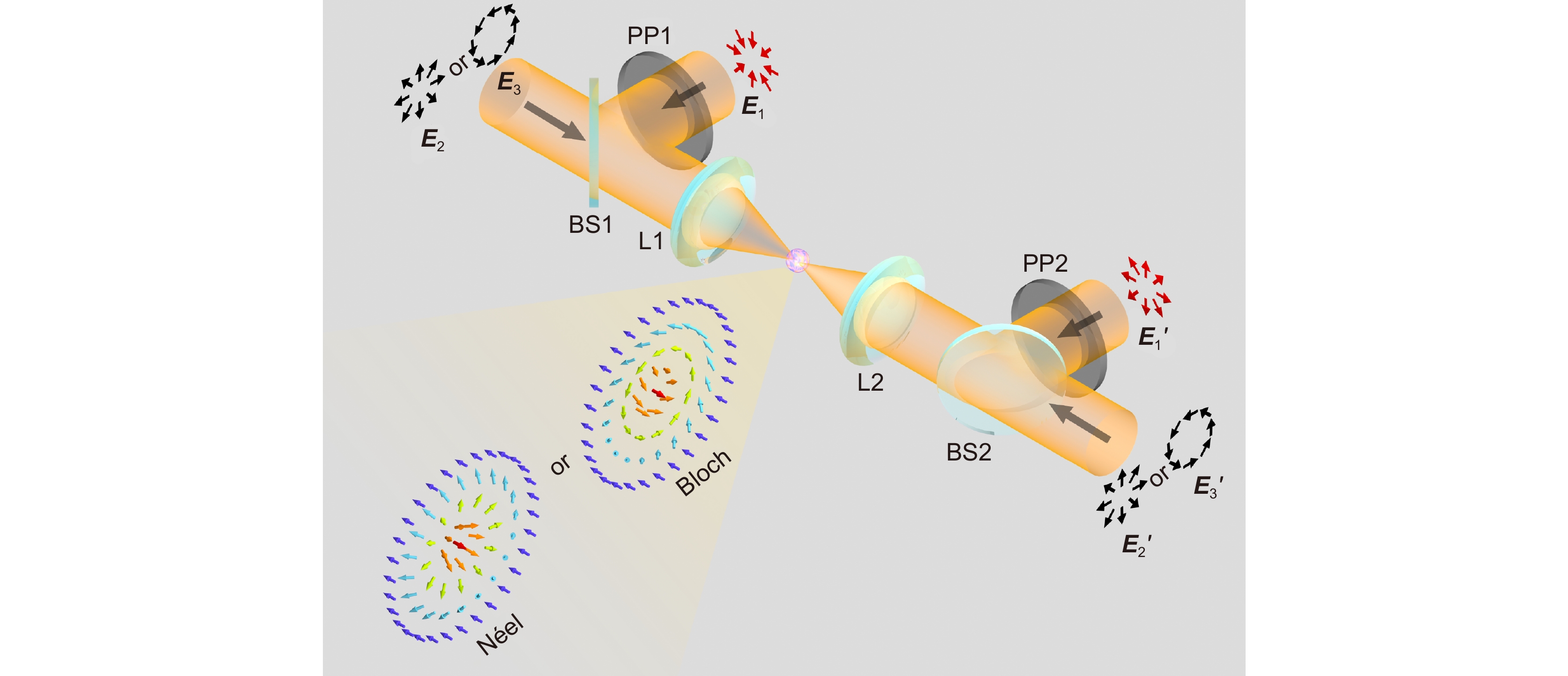
 下载:
下载:
